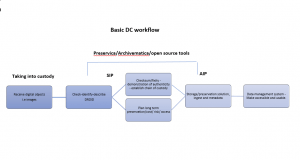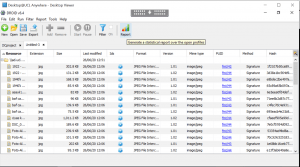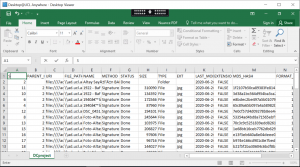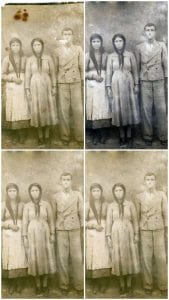Ingest
This is a basic workflow I designed following the DCC lifecycle and OAIS reference model (click on image to enlarge). I found some very useful workflow examples on the BitCurator Consortium, as well as on this blog post on visualising digital preservation workflows.
First action: Receive, describe and characterise
My project began with an inspection of the material as I have received it in cloud storage. There are 87 files. Most in JPEG, some in PDF. I concentrated on 4 files as a single case study. I chose the following 4 files with the labels (in Greek and Turkish) they were given at the collection stage and assigned them accession numbers (in red):
-
Spiros Charitou (name of photographer), PA01
-
Choulou village (name of location), PA02
-
Antigoni Lemona (name of owner possibly), PA03
-
Altat Salyi in BAF photografien (photographer, in Turkish), PA04
In order to take custody, I needed to appraise, identify and characterise the digital objects.
Using DROID, an open source Java application developed by the National Archives to support appraisal and format identification, I inspected and identified the types of files I have received. Running the files through DROID created a report and a hash value for each one. A hash function produces a unique identifying value so you can compare some data to other data and check for duplicates.
(Note: not all hash functions are unique or secure, and the hash value does not necessarily change when the file data changes. Which leads us to the important concept of data fixity, in other words their stability and integrity through time. I will go into fixity in more detail in my next post.)
Files PA01-04 comprise of JPEG, no duplicates were detected. Some images are just different versions of the same image that has been edited in image editing software. I treated them as different files with different hash values as there was no further information on original scan or “object” and edited “improved” versions.
Second action: Take in, transfer, ingest while planning long term preservation
Once I have inspected, identified and accessed the files, in theory deciding what needs to be kept long-term, I need to consider how to take them in and “declare” them as records in my custody.
Ingest means (according to the Digital Curation Centre):
‘transfer data to an archive, repository, data centre or other custodian,’ and ‘adhere to documented guidance, policies or legal requirements.’[1]
Ingest refers to the process of preparing data and digital objects for adding to a digital repository/archive and then adding them to the digital archive.
In this context, ingest (as outlined by the OAIS Reference Model) encompasses “accessioning” in its traditional sense but uses different methodologies and steps to validate the transfer and make the content suitable for long-term preservation.
Preparing objects for access can be adapted to specific circumstances, contexts and resources but it always requires creating inventories, describing contents, redacting sensitive information, and a variety of further activities.
Taking custody of acquired or donated data and digital objects has to be thought through in conjunction with planning for their long-term preservation, the cost, the risk associated with loss and copyright, as well as, access.
Considerations of cost and conditions of stewardship must be made before ingesting materials into a managed repository for curation and preservation. In this instance, I have assumed that the digital objects to be ingested have already been appraised, the 4 files have been identified and selected as appropriate for curation and the issues of cybersecurity (virus and malware scan, personal data and sensitivity review), donation agreement and intellectual property rights have been cleared.
[1] Digital Curation Centre 2004-2015, in Oliver, Digital curation / Gillian Oliver, Ross Harvey, 149.



